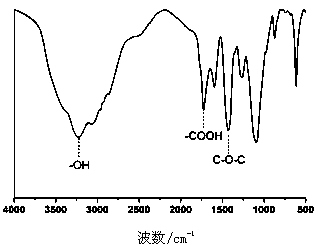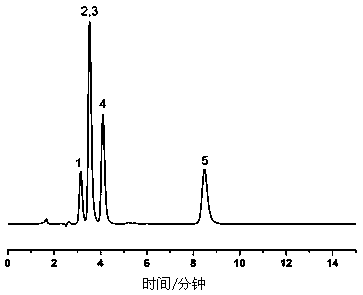Application of graphene quantum dot in hydrophilic chromatographic analysis
A graphene quantum dot and hydrophilic interaction technology, applied in the field of hydrophilic interaction chromatography, can solve problems such as complex bonding schemes, and achieve the effect of enhancing hydrophilic performance and high stability
- Summary
- Abstract
- Description
- Claims
- Application Information
AI Technical Summary
Problems solved by technology
Method used
Image
Examples
Embodiment 1
[0027] Embodiment 1: Preparation of graphene quantum dots containing different functional groups
[0028] Graphene oxide powder (provided by Beijing Deke Daojin Technology Co., Ltd.) was ultrasonically processed to form a 5 mg / mL solution. Take 50 mL of the above solution, add 1 mL ammonia water and 6 mL hydrogen peroxide (30%), and transfer to a 400 mL high-pressure React in the kettle at 200 °C for 3 h, cool to room temperature, filter with a 0.22 µm nylon membrane, dialyze the filtrate with a 500-1000 KDa dialysis bag for 2 days, and freeze-dry to obtain yellow powder graphene quantum dots. Gained graphene quantum dots are separated by silica gel column chromatography to obtain graphene quantum dots containing hydroxyl and alkoxy groups ( figure 1 ) and graphene quantum dots containing hydroxyl, carboxyl and alkoxy groups ( figure 2 ).
Embodiment 2
[0029] Example 2: Separation of alkaloids by graphene quantum dots containing hydroxyl and alkoxy groups in the mode of hydrophilic interaction chromatography
[0030] In a 500 mL round bottom flask, add 200 mg of graphene quantum dots containing hydroxyl and alkoxy groups, 200 mL of N,N-dimethylformamide, sonicate for 15 min to disperse the graphene quantum dots, and then add 100 mg of isocyanate propionate Triethoxysilane reagent, stirred at 80 °C for 6 h to react the hydroxyl groups of graphene quantum dots; 2 g of silica gel was added to the above solution, and the reaction was continued for 6 h. After the reaction, the product was centrifuged and washed three times with water, methanol, and ethanol, respectively, and dried in a vacuum oven at 60°C. Elemental analysis results: C 1.67%, N 0.37%, H 0.67%. Pack the obtained stationary phase packing into a 4.6 mm * 150 mm I.D. stainless steel chromatographic column.
[0031] The prepared chromatographic column was used to te...
Embodiment 3
[0032] Example 3: Separation of alkaloids by graphene quantum dots containing hydroxyl, carboxyl and alkoxy groups in the mode of hydrophilic interaction chromatography
[0033] In a 500 mL round bottom flask, add 200 mg of graphene quantum dots containing hydroxyl, carboxyl and alkoxy groups, 200 mL of N,N-dimethylformamide, sonicate for 15 min to disperse the graphene quantum dots, and then add 100 mg of EDC (1-(3-dimethylaminopropyl)-3-ethylcarbodiimide hydrochloride) / NHS (N-hydroxysuccinimide) coupling agent, stirred at room temperature for 30 min to activate graphene quantum point carboxyl group; add 20 µL of aminopropyltriethoxysilane and stir at room temperature for 12 h. 2 g of silica gel was added to the above solution, the temperature was raised to 80 °C, and the reaction was continued for 6 h. After the reaction, the product was centrifuged and washed three times with water, methanol, and ethanol, respectively, and dried in a vacuum oven at 60°C. Elemental analysi...
PUM
 Login to View More
Login to View More Abstract
Description
Claims
Application Information
 Login to View More
Login to View More - R&D
- Intellectual Property
- Life Sciences
- Materials
- Tech Scout
- Unparalleled Data Quality
- Higher Quality Content
- 60% Fewer Hallucinations
Browse by: Latest US Patents, China's latest patents, Technical Efficacy Thesaurus, Application Domain, Technology Topic, Popular Technical Reports.
© 2025 PatSnap. All rights reserved.Legal|Privacy policy|Modern Slavery Act Transparency Statement|Sitemap|About US| Contact US: help@patsnap.com



